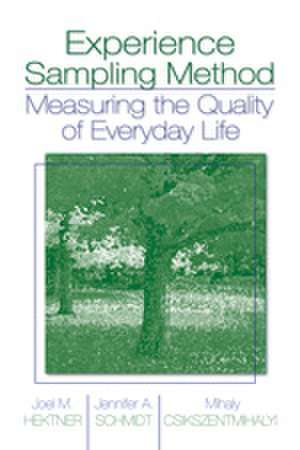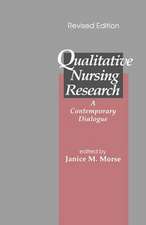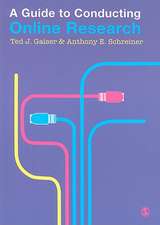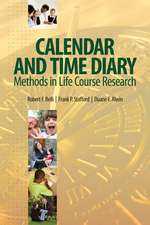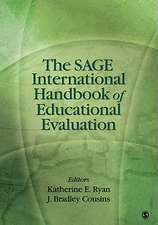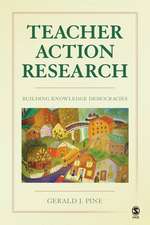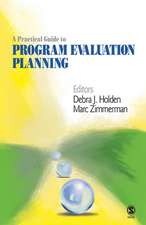Experience Sampling Method: Measuring the Quality of Everyday Life
Autor Joel M. Hektner, Jennifer A. Schmidt, Mihaly Csikszentmihalyien Limba Engleză Paperback – 25 sep 2006
| Toate formatele și edițiile | Preț | Express |
|---|---|---|
| Paperback (1) | 794.92 lei 43-57 zile | |
| SAGE Publications – 25 sep 2006 | 794.92 lei 43-57 zile | |
| Hardback (1) | 1098.23 lei 43-57 zile | |
| SAGE Publications – 13 noi 2006 | 1098.23 lei 43-57 zile |
Preț: 794.92 lei
Preț vechi: 969.42 lei
-18% Nou
Puncte Express: 1192
Preț estimativ în valută:
152.16€ • 165.33$ • 127.89£
152.16€ • 165.33$ • 127.89£
Carte tipărită la comandă
Livrare economică 21 aprilie-05 mai
Preluare comenzi: 021 569.72.76
Specificații
ISBN-13: 9781412925570
ISBN-10: 1412925576
Pagini: 368
Ilustrații: Illustrations
Dimensiuni: 152 x 229 x 20 mm
Greutate: 0.5 kg
Ediția:1
Editura: SAGE Publications
Colecția Sage Publications, Inc
Locul publicării:Thousand Oaks, United States
ISBN-10: 1412925576
Pagini: 368
Ilustrații: Illustrations
Dimensiuni: 152 x 229 x 20 mm
Greutate: 0.5 kg
Ediția:1
Editura: SAGE Publications
Colecția Sage Publications, Inc
Locul publicării:Thousand Oaks, United States
Recenzii
"This book provides interesting reading for students in research method courses and belongs on the must-read list of investigators who are considering the application of ESM to their own research."
Cuprins
List of Tables and Figures
Acknowledgments
Part I: The Origins of ESM
Chapter 1: Epistemological Foundations for the Measurement of Experience
A Systematic Phenomenology
The Experience Sampling Method
A Brief History
How Trustworthy Are Subjective Self-Reports?
What Can We Learn From ESM?
Chapter 2: Theoretical Foundations of ESM
Biology, Culture, and Daily Behavior
Subjective Experience in Context: The Interplay of Psychological Processes and Cognitive Functions
Interaction of Individuals and Environments
Experience Fluctuations, Well-Being, and Development
A Theoretical Compass for Exploring Experience
Part II: How to Measure the Quality of Everyday Life
Chapter 3: Collecting the Data
Designing a Study Using ESM
Equipment and Signaling Schedules
Designing the Form
Other Design Decisions
Implementing the Study
Documentation
Chapter 4: Dealing With the Data: Coding, Entry, Cleaning, and Data Management
Developing a Codebook
Coding the External Coordinates of Experience
Conding the Internal Coordinates of Experience
What to Do With the Codes Once They Are Developed: Physically Coding and Entering the Data
Setup, Cleaning, and Manipulation of Data Files
Response-Level Data and Person-Level Data
Postentry Data Manipulation
Data File Management and Documentation
Chapter 5: Types of Analyses
Qualitative Approaches
Graphic and Numeric Descriptive Information
Planning for Statistical Analyses
OLS Statistical Techniques
Multilevel and Other Complex Statistical Techniques
Chapter 6: Psychometrics of ESM Data
Validity of Method
Validity of ESM Measurements
Reliability of ESM Measurements
Part III: Uses of ESM in Social Science Research
Chapter 7: Samples of Experience
The Who, What, Where, When, and How of Daily Experiences
Quality of Experience in Selected Activities
Quality of Experience of Selected Groups of People
Emotions, Well-Being, and Flow
Chapter 8: The Experience of Males and Females
Differences in Activities
Differences in Companionship
Similiarities and Differences in Emotional Experience
Other Gender Differences in Adolescence
Chapter 9: The Experience of Family Life
Methodological Concerns and Variations
The Couple Relationship
The Arrival of the First Child
Juggling Work and Family Roles
The Adolescent's Experience of Family
Transmission of Emotions Between Family Members
Comparisons Between Families: Optimal Conditions for Adolescent Development
Chapter 10: The Experience of Work
Methodological Concerns and Variations
Time and Work
The Quality of Experience at Work: General Trends
The Quality of Experience Across Workers
The Quality of Experience Across Work Activities
The Intersection of Work and Family
The Experience of Unemployment
Adolescent Work
Chapter 11: Examining Cross-Cultural Differences
Methodological Concerns and Variations
Culture and Time Use
Cross-Cultural Variation in General Affective Experience
Culture and Subjective Experience in Various Activities
Cross-Cultural Examination of Flow
Studies of American Subcultures
Chapter 12: Educational Applications
Methodological Concerns and Variations
Time Use and Structure of Classrooms
The Quality of Students' Classroom Experiences
Comparing Students' Classroom Experiences
After-School Programs
Studies of Adult Learners
The Experience of Teachers
Chapter 13: Clinical Applications
Methodological Concerns and Variations
Use of ESM for Describing and Contextualizing Experiences of Disorder
Use of ESM in Therapy and in Treatment Evaluation
Concluding Thoughts
Ten Major Issues ESM Illuminates
Appendix A: Sample ESM Data Collection Forms (ESFs)
Appendix B: ESM Coding Scheme Used in the Sloan Study of Youth and Social Development
References
Index
About the Authors
Acknowledgments
Part I: The Origins of ESM
Chapter 1: Epistemological Foundations for the Measurement of Experience
A Systematic Phenomenology
The Experience Sampling Method
A Brief History
How Trustworthy Are Subjective Self-Reports?
What Can We Learn From ESM?
Chapter 2: Theoretical Foundations of ESM
Biology, Culture, and Daily Behavior
Subjective Experience in Context: The Interplay of Psychological Processes and Cognitive Functions
Interaction of Individuals and Environments
Experience Fluctuations, Well-Being, and Development
A Theoretical Compass for Exploring Experience
Part II: How to Measure the Quality of Everyday Life
Chapter 3: Collecting the Data
Designing a Study Using ESM
Equipment and Signaling Schedules
Designing the Form
Other Design Decisions
Implementing the Study
Documentation
Chapter 4: Dealing With the Data: Coding, Entry, Cleaning, and Data Management
Developing a Codebook
Coding the External Coordinates of Experience
Conding the Internal Coordinates of Experience
What to Do With the Codes Once They Are Developed: Physically Coding and Entering the Data
Setup, Cleaning, and Manipulation of Data Files
Response-Level Data and Person-Level Data
Postentry Data Manipulation
Data File Management and Documentation
Chapter 5: Types of Analyses
Qualitative Approaches
Graphic and Numeric Descriptive Information
Planning for Statistical Analyses
OLS Statistical Techniques
Multilevel and Other Complex Statistical Techniques
Chapter 6: Psychometrics of ESM Data
Validity of Method
Validity of ESM Measurements
Reliability of ESM Measurements
Part III: Uses of ESM in Social Science Research
Chapter 7: Samples of Experience
The Who, What, Where, When, and How of Daily Experiences
Quality of Experience in Selected Activities
Quality of Experience of Selected Groups of People
Emotions, Well-Being, and Flow
Chapter 8: The Experience of Males and Females
Differences in Activities
Differences in Companionship
Similiarities and Differences in Emotional Experience
Other Gender Differences in Adolescence
Chapter 9: The Experience of Family Life
Methodological Concerns and Variations
The Couple Relationship
The Arrival of the First Child
Juggling Work and Family Roles
The Adolescent's Experience of Family
Transmission of Emotions Between Family Members
Comparisons Between Families: Optimal Conditions for Adolescent Development
Chapter 10: The Experience of Work
Methodological Concerns and Variations
Time and Work
The Quality of Experience at Work: General Trends
The Quality of Experience Across Workers
The Quality of Experience Across Work Activities
The Intersection of Work and Family
The Experience of Unemployment
Adolescent Work
Chapter 11: Examining Cross-Cultural Differences
Methodological Concerns and Variations
Culture and Time Use
Cross-Cultural Variation in General Affective Experience
Culture and Subjective Experience in Various Activities
Cross-Cultural Examination of Flow
Studies of American Subcultures
Chapter 12: Educational Applications
Methodological Concerns and Variations
Time Use and Structure of Classrooms
The Quality of Students' Classroom Experiences
Comparing Students' Classroom Experiences
After-School Programs
Studies of Adult Learners
The Experience of Teachers
Chapter 13: Clinical Applications
Methodological Concerns and Variations
Use of ESM for Describing and Contextualizing Experiences of Disorder
Use of ESM in Therapy and in Treatment Evaluation
Concluding Thoughts
Ten Major Issues ESM Illuminates
Appendix A: Sample ESM Data Collection Forms (ESFs)
Appendix B: ESM Coding Scheme Used in the Sloan Study of Youth and Social Development
References
Index
About the Authors
Notă biografică
Joel M. Hektner is an Associate Professor in Human Development and Family Science at North Dakota State University. He holds a Ph.D. in Psychology: Human Development from the University of Chicago and an A.B. in psychology from Princeton University. Before arriving at NDSU, Hektner was a research scientist in child and adolescent psychiatry at the University of Minnesota. He has used ESM to study the developmental implications of longitudinal changes in adolescent experiences of flow and has written chapters on ESM in several books. In collaboration with students, he has conducted ESM studies of college students, adolescents in residential treatment, and LGB emerging adults. His research interests primarily involve family and peer factors that promote optimal development and evaluations of preventive interventions for antisocial behavior. He is presently working on strategies to strengthen positive peer culture among elementary and middle school children, and to promote more positive parent-child relations.
Descriere
Experience Sampling Method: Measuring the Quality of Everyday Life is the first book to bring together the theoretical foundations and practical applications of this indispensable methodology. Authors Joel M. Hektner, Jennifer A. Schmidt, and Mihaly Csikszentmihalyi provide fascinating information for anyone interested in how people go about their daily lives.
